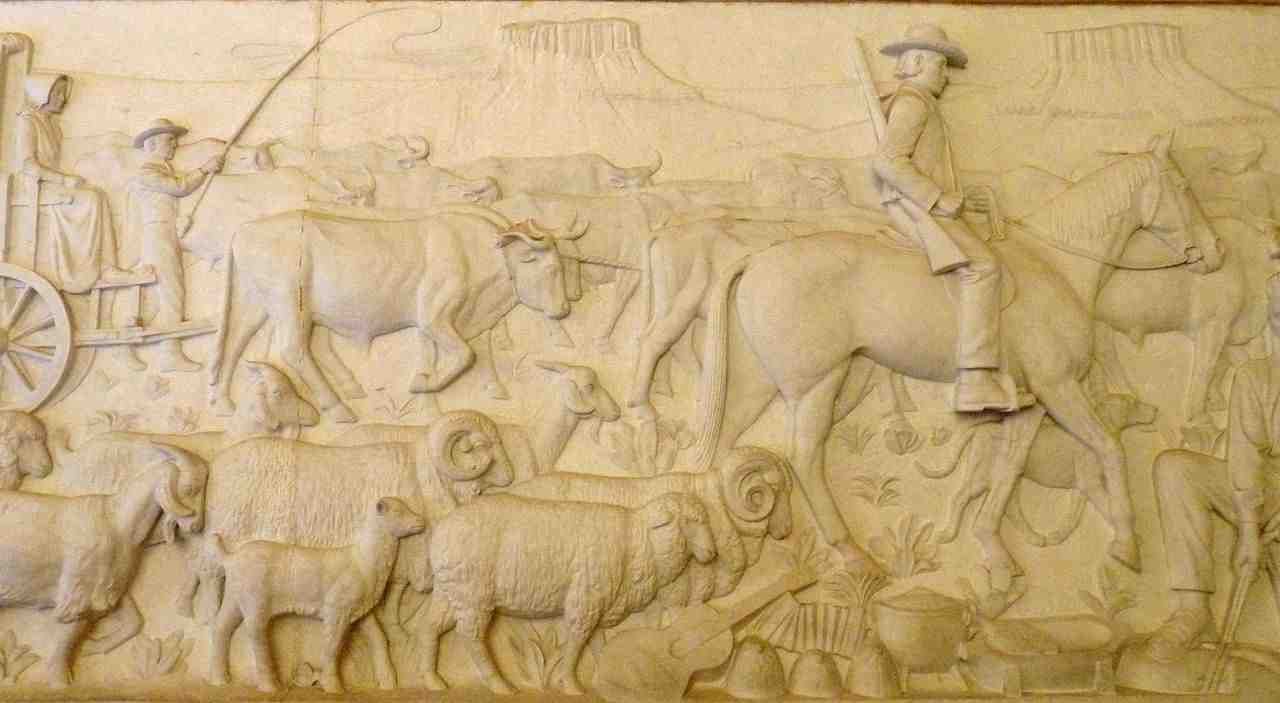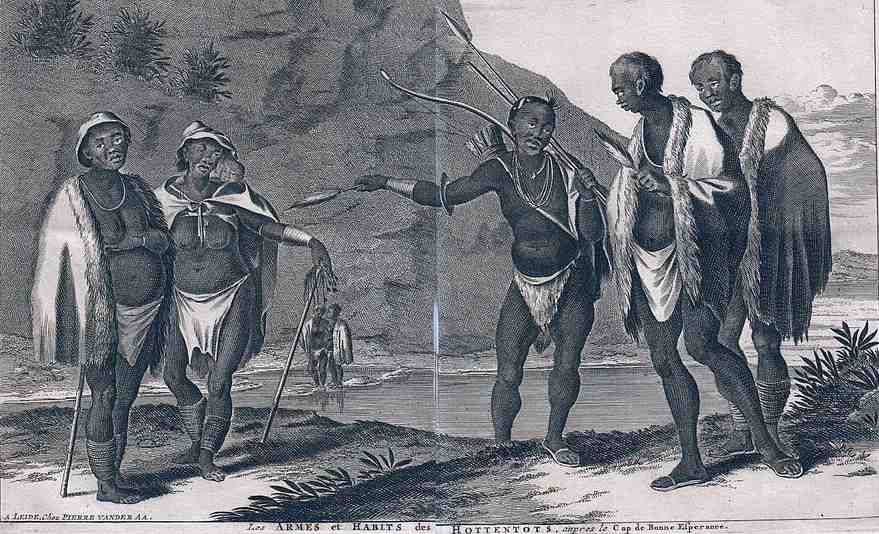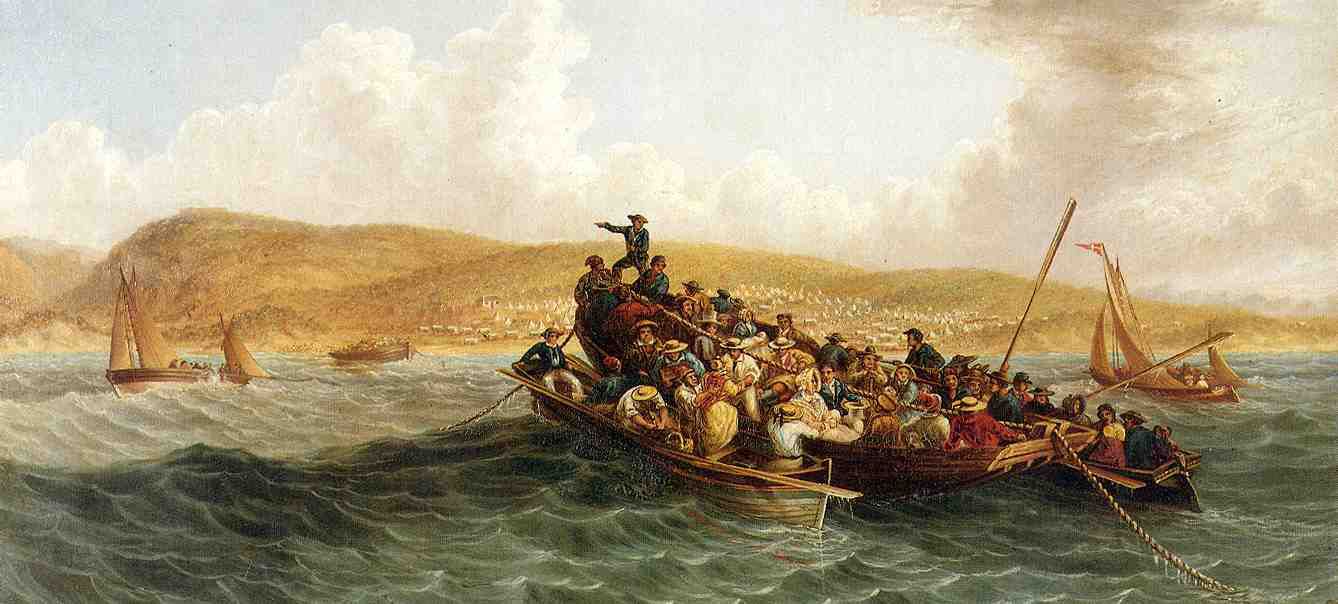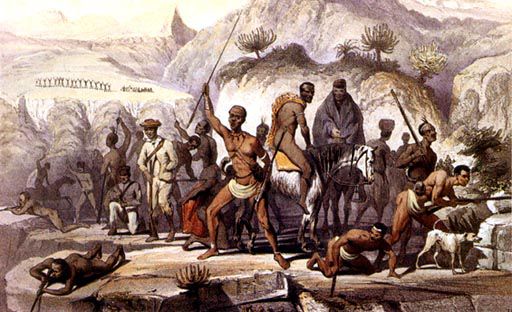
My line-by-line comments on the vital Voortrekker chapter comprised fifty pages plus numerous side notes. Here is a sampling from the first seven pages of my report.
In my overview of Michener's draft for The Voortrekker chapter in The Covenant, I commented:
"Not one of characters, Tjaart Van Doorn, Naude, Bronk, Nel etc. even suggest picture of 'frontier Boer' - i.e. the wilder, independent, hard as nails individual. What we have is picture that evokes American Centennial-type character + the Pennsylvania Dutch.
Unsettling frontier element isn't there, the balance between Bible-living Van Doorns and wild renegade types, which if time allowed, I'd show in 50/50 proportion, is lacking.
We have a stylized Afrikaner-heroic interpretation, which was good enough for the past and Nathan (Manfred Nathan, The Voortrekkers of South Africa, 1937) but inadequate for 1980.
In addition, we have scant reference to the dominant issue then and now, i.e. LABOR.Sure, one might argue that the American reader only needs simplistic view. But it's wrong to offer it this simply. It just wasn't so."
The Voortrekkers - Chapter X, The Covenant
Errol Lincoln Uys / October 1979 - Line-by-Line Review of Michener's manuscript.[My line-by-line comments on the vital Voortrekker chapter comprised fifty pages plus numerous side notes. Here is a sampling from the first seven pages of my report. - From numerous sources/images added to website.]
1.6 What Tjaart had done was accumulate much pasturage beyond the hills
Little land had been granted since 1807 when the government was giving consideration to a new system of tenure: loan-place to quit-rent etc."
In 1813 Cradock said that he had at least 3,000 petitions for land.
This contradicts one of the basic reasons for the trek - if not the reason: land shortage. Some pointers to the background:In 1824 there were over 1,000 petitions for land in the Graaff Reinet district, by the end of that year only 140,352 morgen had been granted in the district.
In Graaff Reinet by the end of 1822, of 392 convertible loan farms 56 had been converted, and a further 301 applications were on file. As their petitions for new land were not dealt with until the titles of converted loan farms had been issued, and as few Boers had titles for their converted loan farms, they were unable legally to occupy new land. There arose 'request' places: land for which petitions had been submitted to the government, with the approval of the landrost, who often registered the claim in his books, although the government condemned the practice. In Graaff Reinet in 1824, there were at least 1,000 request places. (It is interesting to note that of the 19 men from the rural areas of the district who were reported to have joined the Great Trek by early 1837, 15 were described as having no fixed place of residence.)By 1836, only 706 conversions on loan farms had been made which meant that there were still 1500 loan farms dating back to before 1813.
Meanwhile in 1832 the government, under orders from the Colonial Office, announced that all land applied for after 9 January 1832 would be sold only by public auction. Several historians emphasize this 'auction' decision in grievance list. There is much more material available to show the tremendous pressure that had arisen in the area of land usage/availability. Thus when d'Urban annexed 'Queen Adelaide Province,' the move was greatly welcomed by hundreds of land-hungry Boers who, at last, saw an advance of the frontier and the possibility of new farms. There are records of two, three Boer families at this time being 'forced' to exist on what their forefathers would've regarded as one unit i.e. 6,000 morgen. [approx 12,000 acres.]

2.1 the house now had an ell
This seems to hark back to Trianon-type? 'Any number lived in single roomed cottages, divided in two by rush screens, sod-walled and thatched with reeds and grass. House of the more comfortable was like a big oblong barn, thatched and whitewashed with two or three rooms.
2.2 in which Jakoba and Minna could do their cooking
Streak: 'A black slave woman and a Hottentot girl assisted in domestic duties while the more laborious work was performed by a man slave and a few Hottentots.' - This would be typical of the more prosperous type like Van Doorn/Retief etc.
2.3 the nineteen slaves
As in previous chapter, emphasis/differences/laws regarding a) slaves b) Hottentots/'Coloureds'/freed blacks and c) Xhosa is confused. Since the turn of the 19th century, the three groups had become the subject of separate legislation. A second dominant issue - available labor - stems directly from these groups and the laws passed either to control or 'emancipate' them. The major developments for a) b) and c) were:
The Hottentots (Note: Historical word considered pejorative, now called Khoi or Khoikhoi)
1800 By now Hottentot laborers had to be registered with Veld Kornet.(Spilhaus:"Proclamations long before the advent of the British had declared it to be the law of the land that the Hottentot, his life and his property should be protected on an equality with the colonists." When the Dutch Government - the Batavian Republic - after the peace of Amiens came to take over the government, it was the same thing again. However, the colonists had never reconciled themselves to such an idea.)
In 1797 Barrow noted that Graaff Reinet had 10,000 Khoikhoi and Coloured servants, and there were over 15,000 in the Colony. Caledon's Nov 1,1809 proclamation owed much to work of Stockenström, sr. and Maynier in Graaff Reinet after the Khoikhoi rebellion of 1799 and to the Batavian legislation: Every Hottentot had to choose a fixed domicile. The regulation entailed that a Hottentot was no longer able to move to other places without a permit issued by the magistrate where his domicile was registered i.e. a 'pass' law. Employment of Hottentots for any period exceeding a month could only be effected by written contract and was subject to provisions which protected the employee against exploitation. By the same proclamation wandering Hottentots were thus required to carry passes
The Hottentots thus became full members of the colonial community, falling under the jurisdiction of the courts, liable to taxation and the performance of public services.
[Malherbe's census: White/Hottentot + Free Black: 1806 W 26,768 H/FB 50,000; 1821 W 47,280 H/FB 75,000; 1831 W 60,000 H/FB 66,000]
Reaction? Consider, for example the approach to Maynier earlier (1801). The Graaff Reinet 'rebels' wished:

The Slaves
The manumission of individual slaves who had worked for 30 years, learnt Dutch, and been converted to Christianity was a standing tradition at the Cape. So effective had the ban on the sale of Christian slaves been, as a deterrent to slave baptism that it was withdrawn by Cradock in 1812
1826: The Slave Ordinance entitled slaves to give evidence against their masters in criminal cases and to buy their freedom by offering to pay their assessed value. It also provided an additional protection against ill-treatment with owners risking
forfeiture of their property in slaves.
(1816:) April Somerset had instituted a slave registry - the purpose of which was to check the importation of new slaves (forbidden in 1807) or the enslavement of free blacks.
(1823:) Proclamation designed to facilitate the admission of slaves to the Christian church and their marriage by Christian rites, to validate the oath of a Christian slave in a court of law, to ensure proper food and clothing, to limit working hours etc. (Oxford p 306) This was embodied in 1826 proclamation (above.) From 1826 -1831 there were protests throughout the Cape to these provisions, some were modified, a constitutional difficulty arose over actions taken, and in 1830, the Imperial Government issued an Order-in-Council passing the law. In June 1831 a minor outbreak of violence occurred in Stellenbosch. (In 1820, the British settlers were forbidden slaves.)
1826 Guardian of Slaves appointed - "Protector" in 1830.
1831 Nov All previous regulations tightened up - particularly Sunday work, diet and authority of Protector. Gatherings banned, threat of deportation for protestors. Some relaxation of measures but only aAbolition of Slaveryt Act 1833, click to enlarge matter of a year before.
1833 May House of Commons votes for abolition in British Empire all slaves to be set free December 1834 but apprenticed thereafter to owners for four to six years.
At no point were Afrikaners like Van Doorn able to enslave the 'Kaffirs'. At a later stage in text it also appears strange that Van Doorn should be so surprised by the news that they're to be emancipated. And, finally, it's important to bear in mind that of the 39,000 slaves in the Cape at the time of emancipation, only 2,175 were in the Graaff Reinet District.
The Xhosa
In 1833, a man like Van Doorn would have been as unhappy as possible with the situation:
In 1830 the Dutch farmers were excluded from the ceded territory taken after the 1819 war and only for English and Hottentot. In 1826 Somerset's reprisal system has been reversed. Ordinance 49 of 1828 brought some relief: It provided for Xhosa seeking work to enter colony.
Walker: "A few Bantu already working in colony, but in keeping with traditional policy of segregation regarded as interlopers."
Until the 1828 Ordinance it was general illegal to employ Xhosa. However, such employment was minimal. By 1853, there were 768 Africans employed in the Graaff Reinet district - the main influx coming after the cattle-killing of 1857 which caused over 30,000 Xhosa to enter the colony.
For a people with a slave-owning mentality, long accustomed to the lekker lewe (easy life) the situation was serious.
"The census figures for Graaff Reinet district 1806-1824 show that Graaff Reinet, Retief House, the number of Hottentot men was roughly equal to the number of Boer men, and that the inclusion of nearly all the Hottentot males below the age of 16 gave less than a ratio of two to one. The statement of CH Olivier in 1826 that most of the Boers of Graaff Reinet tended their cattle themselves may well contain a measure of truth. Barend Vorster asked to be relieved of his duties as veld cornet as he had no servants, and had to care for his livestock himself.
Such accounts of Boers without servants are more numerous in the period after 1828. Cloete personally vouched for the fact that he had known farms which had been completely abandoned, by the last remaining Hottentots having given up service, or retired to the missionary schools.
MJ Herholdt, who was born in the field cornetcy of Voor Sneeuberg said that as a boy 'het oppaschen der schapen werd tussen de broeders verdeelt, en wel zoo dat ik de eene week ter school ging en het ander week het herders ambt moest verrigen.' Steedman's party met a Boer family in the vicinity of the Sneeuberg who were without servants.' The Hottentots whom they had brought up from childhood had lately left them and they were at this time almost destitute of aid, having no means of engaging others.' (GRH 190.)
We'll get into all this below, but important thing is not to overstate the hatred of the English as a cause of the trek. There were other more and most certainly equally important factors. Land Shortage/ Labor Shortage/ Insecurity of Frontier Life/ Fluctuations of British Policy.
2.4 the farm... 9000 plus 16000 = 25000 acresHighly unlikely by this stage unless he was in the remote northern regions but we know that he is 90 miles south of Graaff Reinet. Moreover, by 1833, the whole land ownership situation in Graaff Reinet/ Uitenhage area not in one vague capacity or other
2.5 a man of considerable wealth and could look forward to a prosperous and placid old age
In view of what's said above, unless he was strongly in the camp of a man like Andries Stockenström jr. or Landrost Cuyler, strongly committed to the British, this would be unlikely. Retief, Maritz, Uys all lay somewhere between the border 'trash' like Bezuidenhouts etc. and the colonists who would not move away. By 1833 they were sorely troubled by all that had happened, and much encouraged by all reports filtering in from beyond the Xhosa 'barrier'.
2.6 money cast the first shadow
In addition to the shadows cast by land needs/labor (above), there were a host of others that would've made an impression:
Charter of Justice 1827 English magisterial system replacing landrosts and heemraden
Kat River settlement of Khoikhoi and similar
Hundreds, maybe thousands of 'vagrants'
English usage in courts, government
Cape trade preferences slowly withdrawn
Add ref land: "In 1809 Col. Collins found the land occupied to the northernmost point of the border. Almost everywhere in the colony he found people wanting farms, and people without farms, some living with relatives, some wandering from place to place. Stockenström who knew his district, in 1826, maintained that "There is not even a stagnant pool that keeps rainwater for any length of time which is not regularly occupied, so that of course no spring remains vacant, and for many of them there are three or four occupants, the whole population consisting of persons who have not another place in the world." (GRH 43)
2.7. the new port
Established in 1819/20, Port Elizabeth by 1833 had a population of 1,200
2.8 where the Atlantic and Indian Oceans meet
At Cape Agulhas, not Algoa Bay
2.9 the new English sterling currency which had replaced the Dutch rix dollar
you've got to turn the old money in.
the bright shillings
the new laws the English were quietly introducing.
The conversion was in 1825
The Batavians left the rix dollar at its par value of 4/- when they departed in 1806. Serious inflation began. The British, however, issued another one million rix dollars in 1810-1815. In 1825, the Imperial Government decided to convert the foreign currencies of all annexed colonies to sterling. When this was done the rix dollar had fallen to 1/6d. The outcry among colonial creditors was great, and the government was obliged to leave it as legal tender till 1841.
In 1825 it introduced British silver, 5s 2/6d 1s and 6d and copper. In 1832 issues of paper money in sterling denominations were made for the first time. The change to sterling currency was finally completed in 1881
As above, the laws were introduced far from quietly apropos the Coloureds/ rule of law/English etc.
2.10 chipped and beaten coinage the Dutch had provided
Paper rix dollars introduced in 1780's - by 1795 over million paper rix dollars in circulation.
3.1 their new prosperity
In 1833/34 aside from the war, discussed below, the frontier was ravaged by drought.
Walker: 'The frontiers were cracking under combined pressure of drought, teeming families, threatened auction of crown lands and knowledge that there was better land further afield.'
So Van Doorn and de Groot would be rare exception. When one considers that all this is on the eve of the trek, easy to realize that it was really the end of the line for those who had put so many hopes in the new frontier.

3.2 most Boers now accepted the English presence without complaint
Definitely not - unless they were part of the Establishment in the Western Cape. They were complaining louder than ever but it shouldn't be thought, either, that their distaste for authority was confined to the 'English': Even in the days of the Dutch, as shown again and again, the government had been in their eyes something alien and hostile.
Walker says, of 1825 onwards: 'All these changes were baffling and irritating to a suspicious people deeply imbedded in old ways — but worse was the policy of land security and labor: the establishment of the Hottentot settlements, the 1832 decision on the auctioning of crown lands - before these could be taken up simply as 'loan places' - the 1828 Ordinance 50.
'The effect of all this was that it appeared to a) tax the freeborn Afrikaner when it gave little in return b) it tried to stop them trekking beyond colonial borders c) tried to prevent them shooting game d) forbade them to deal with the natives.
'Root cause was the steady advance of forces of regular government paving way for the coming of new social and economic forces."
As with Walker and others, dangers of taking a caricature line. A marvelous unanswered query
3.3 the new settlers
Certainly there is scope for a harmony of interests between the Boer farmers and the 1820 Settler farmers - but this would extend to joint grievances against the English authority. An authority which, worth noting, was largely exercised by Dutchmen of the Stockenström/Cuyler/Cloete mold.)
3.4 on four recent occasions -- to help the English defend the little town
Grahamstown was attacked 1819. Next invasion of colony - 1834. Certainly intermittent cattle raids etc by Xhosa and, perhaps more so, by 'banditti' in shape of Hottenot-Coloured-Bush gangs. But no Xhosa 'besiegers' or protracted wars. 1819 was the 5th Xhosa War; 1835, the Sixth. 1850 the seventh
3.5 as a hunting party at Die Kraal(NOTE: Usage of the word "kaffir" in a modern South African context is a pejorative, as unacceptable today as its American counterpart. )
4.1 kaffir slave woman
No.
...would get drunk on the weak beer that was provided
They would make their own potent brew
4.2 a sack tied about the middle
dress had a turn-over collar, fairly wide sleeves fastened at the wrists, and flounces round the lower part of the skirt
dangling blond pigtails
women never wore their hair loose, not even little girls, but parted it in the middle, smoothed it back and fastened it in a bun behind with a tortoiseshell comb
she 'worked like an adult'/ 'knew how to handle farm materials '
This does not accord with suggestion that Van Doorn is a prosperous farmer with 19 'slaves' and, one assumes, at least the same number of Hottentots
Confusion about the type of Boer Van Doorn is: with 19 'slaves' and God knows how many Hottentots etc., he would be in Pretorius/Gerrit Maritz rank.
4.3 adept at spinning Tjaart's wool into strong thread and thick cloth
No record whatever of this: For one thing, the Boer sheep were not yet raised for wool. In 1836, the entire Graaff Reinet district exported 116,000 lbs
5.l Nagmaal
Spelled "Nachtmaal" at this stage but other is correct Afrikaans.
strode over to her bed
Still live in one room?
male slaves were coached
Makes it sound more lake U.S. plantation. Long absence? 2 weeks?
6.1 farm of Piet Retief
Retief's farm was in the Winterberg north-east of Graaff Reinet
sixth time the Boers had ridden to the defense of the English
reported without ever a hesitation
Yet Cole, with consent of veld cornets, had to pass law compelling them?
expected the Boer commandos to come thundering in to Grahamstown
a harmony of interests had developed
The war of 1833 was a brief, harsh affair
The Xhosa wars, brief or otherwise are well documented. This picture of Boer commandos riding to the relief of the Grahamstown settlers is too simple - It did not happen.
At this very time, governor Cole was forced to revise commando laws - imposing penalties for those who did not turn up - Again and again, we see reluctance to report for duty. Maybe this crowd are exceptions...
A harmony of interests may have developed with individual settlers like Saltwood and Charleton but certainly not with the English authority.(see above.)
The war of 1833?
Oxford: "Wars with Xhosa broke out 14 years after arrival of the 1820 settlers and three times in 30
years their homesteads were burnt etc.
ordered four of his Hottentots to join him.
As noted in last chapter the term Hottentot can be misleading. In 1800's Coloured people of the
colony comprised besides a handful of Bushmen (San), a widely scattered population of freemen
loosely known as Hottentots and roughly equal in number to the slaves of foreign origin.
6.3 indunas
Zulu = headman
7.1 a formal war was in progress
Fiction. It may be important to use 1834/1835 war, the biggest disaster ever. And if that's line to take, then shift beginning of chapter to immediately post-1828 law.
the few guns they had been able to beg or capture.
Guns would've come from traders/illegal runners. A far better option for this section would be to
have them contest a band of vagabond raiders of mixed make-up i.e. Coloured/ Hottentot/ Bush/
Griqua, a direct outcome of the 1828 Ordinance
7.3 four battles ??? a Boer lance ??? The Grahamstown Irregular
Suggests that there were no regular British troops available?
[End of excerpt from Uys research report on The Voortrekkers in The Covernant.]
